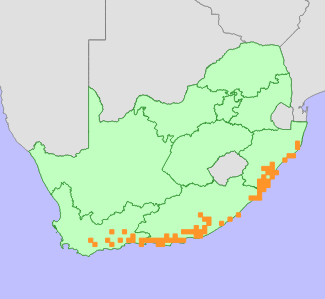|
Scientific Name | Heliophila elongata (Thunb.) DC. |
Higher Classification | Dicotyledons |
Family | BRASSICACEAE |
Synonyms | Cheiranthus elongatus Thunb., Heliophila dolichostyla Schltr., Heliophila stylosa Burch. ex DC., Heliophila stylosa Burch. ex DC. var. lobata Sond., Heliophila virgata Burch. ex DC., Heliophila virgata Burch. ex DC. var. dentata Burch. ex DC., Heliophila virgata Burch. ex DC. var. integrifolia Burch. ex DC. |
National Status |
Status and Criteria | Least Concern |
Assessment Date | 2018/07/05 |
Assessor(s) | L. von Staden |
Justification | Heliophila elongata is a widespread and common species, with an extent of occurrence (EOO) of 213 009 km². There is ongoing habitat loss and degradation across most of its range, but it is not yet in danger of extinction. It is therefore listed as Least Concern. |
Distribution |
Endemism | South African endemic |
Provincial distribution | Eastern Cape, KwaZulu-Natal, Western Cape |
Range | This species is endemic and widespread along the east coast of South Africa, from the Maputaland Flats in northern KwaZulu-Natal to the southern Cape. |
Habitat and Ecology |
Major system | Terrestrial |
Major habitats | South Swartberg Sandstone Fynbos, Maputaland Coastal Belt, Maputaland Wooded Grassland, KwaZulu-Natal Coastal Belt Grassland, Pondoland-Ugu Sandstone Coastal Sourveld, Transkei Coastal Belt, Swellendam Silcrete Fynbos, Knysna Sand Fynbos, Albertinia Sand Fynbos, Garden Route Granite Fynbos, Suurberg Quartzite Fynbos, South Langeberg Sandstone Fynbos, North Outeniqua Sandstone Fynbos, Kasouga Dune Thicket, Tsitsikamma Sandstone Fynbos, South Eastern Coastal Thornveld, South Kammanassie Sandstone Fynbos, Kouga Sandstone Fynbos, Kouga Grassy Sandstone Fynbos, Algoa Sandstone Fynbos, Amathole Mistbelt Grassland, Dry Coast Hinterland Grassland, Moist Coast Hinterland Grassland, KwaZulu-Natal Hinterland Thornveld, Ngongoni Veld, KwaZulu-Natal Sandstone Sourveld, Eastern Valley Bushveld, Bhisho Thornveld, South Outeniqua Sandstone Fynbos |
Description | It occurs in coastal grasslands and fynbos. |
Threats |
| At least 40% of this species' habitat is irreversibly modified, predominantly due to historical loss to sugarcane cultivation on the KwaZulu-Natal coast, as well as urban expansion and coastal developments in popular holiday destinations such as the Garden Route and the KwaZulu-Natal South Coast. Habitat loss and degradation continues, particularly in small, isolated remnants, which are typically impacted by spreading alien invasive plants and inappropriate fire management. Along the Eastern Cape coast between East London and Port Edward it is threatened by ongoing habitat degradation due to overgrazing. |
Population |
There is no information available on its population.
|
Population trend | Decreasing |
Assessment History |
Taxon assessed |
Status and Criteria |
Citation/Red List version | | Heliophila elongata (Thunb.) DC. | Least Concern | Raimondo et al. (2009) | |
Bibliography |
Goldblatt, P. and Manning, J.C. 2000. Cape Plants: A conspectus of the Cape Flora of South Africa. Strelitzia 9. National Botanical Institute, Cape Town.
Manning, J.C. and Goldblatt, P. 2012. Plants of the Greater Cape Floristic Region 1: The Core Cape Flora. Strelitzia 29. South African National Biodiversity Institute, Pretoria.
Marais, W. 1970. Cruciferae. In: L.E. Codd, B. De Winter, D.J.B. Killick and H.B. Rycroft (eds). Flora of southern Africa 13:1-118. Botanical Research Institute, Pretoria.
Raimondo, D., von Staden, L., Foden, W., Victor, J.E., Helme, N.A., Turner, R.C., Kamundi, D.A. and Manyama, P.A. 2009. Red List of South African Plants. Strelitzia 25. South African National Biodiversity Institute, Pretoria.
|
Citation |
| von Staden, L. 2018. Heliophila elongata (Thunb.) DC. National Assessment: Red List of South African Plants version 2024.1. Accessed on 2025/12/13 |
 Comment on this assessment
Comment on this assessment


